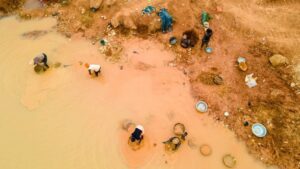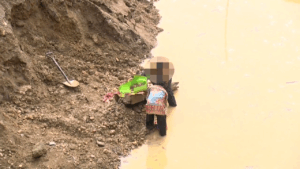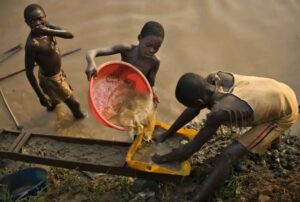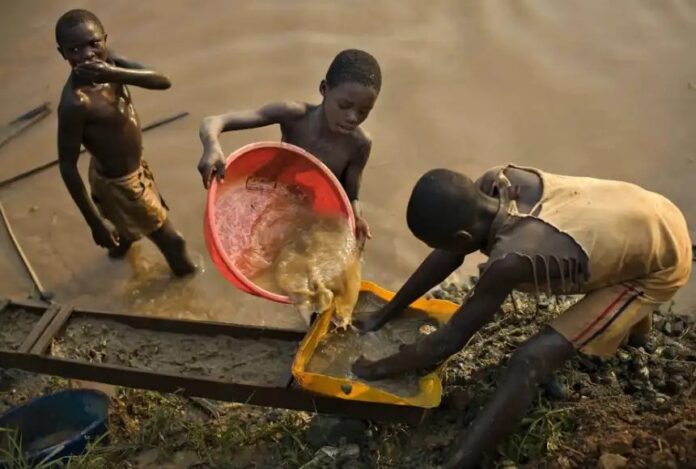In commemoration of the upcoming World Day Against Trafficking in Persons, OAfrica, a leading child-focused non-profit organisation, will host a high-level national forum in Accra on Wednesday, July 30, to rally stakeholders behind urgent efforts to end child labour in illegal small-scale mining – popularly known as galamsey.
The forum, themed “Poisoned Playgrounds: Ending Child Labour in Galamsey,” aims to spotlight the devastating impact of galamsey on Ghana’s most vulnerable – children – and to build a coalition of voices demanding decisive action from government and communities.

Understanding galamsey: economic lifeline and looming crisis
Small-scale mining or “Galamsey” as it is commonly known in Ghana, has historically played a significant role in the economic fabric of many rural communities. It provides a direct source of livelihood for thousands of individuals and families, contributing to local economies and, in some instances, serving as an engine of economic prosperity. For many, it represents the most accessible path to income, particularly in areas where alternative opportunities are scarce.
However, the unregulated and often illegal nature of much of this activity has given rise to a severe humanitarian and environmental crisis, with children bearing the heaviest burden. While acknowledging the economic realities that drive Galamsey, OAfrica and its partners emphasise that these benefits must never come at the cost of a child’s health, education, and fundamental rights.
The grave consequences: Children in the crucible of galamsey
The forum will highlight the alarming proliferation of children in Galamsey sites, a phenomenon that has escalated into a national emergency. These “poisoned playgrounds” expose children to a litany of dangers, fundamentally compromising their well-being and future.
- Child labour and trafficking: Children, some as young as five, are increasingly found engaged in arduous and hazardous tasks within Galamsey operations. They dig, carry heavy loads of ore, wash gold-bearing gravel in contaminated rivers, and even dive into murky pits. This constitutes child labour, a direct violation of their rights. Furthermore, reports indicate a disturbing rise in child trafficking, where children are lured or forced into these sites under false pretences, often separated from their families and exploited for their cheap labour. This exploitation is a modern form of slavery, stripping children of their freedom and dignity.

- Devastating health impacts: The health consequences for children involved in Galamsey are dire and often irreversible.
- Mercury poisoning: One of the most insidious threats is mercury exposure, a highly toxic heavy metal used in gold amalgamation. Children, due to their smaller body mass and developing systems, are particularly vulnerable. Mercury exposure can lead to severe neurological damage, affecting cognitive function, motor skills, and speech. It can cause kidney damage, respiratory problems, and skin disorders.
- Heavy metal exposure: Beyond mercury, children are also exposed to other heavy metals, such as lead, arsenic, and cadmium, which are present in soil and water. These can cause stunted growth, developmental delays, organ damage, and increase the risk of various cancers.
- Physical injuries and respiratory illnesses: The dangerous working conditions lead to frequent injuries, including cuts, fractures, and even fatalities from collapsing pits. The constant inhalation of dust and fumes from machinery and chemicals contributes to the development of chronic respiratory illnesses.
- Environmental degradation and its ripple effect on children: The destructive environmental practices of Galamsey, such as deforestation, soil erosion, and the pollution of water bodies, indirectly but profoundly impact children. Contaminated water sources lead to waterborne diseases, affecting community health, particularly children who are more susceptible to infections. The destruction of agricultural land also threatens food security, exacerbating poverty and pushing more children towards Galamsey for survival.
- Stolen childhoods and diminished futures: Perhaps the most tragic consequence is the loss of childhood itself. Children abandon school, sacrificing their education for meagre earnings. This perpetuates a cycle of poverty, denying them the skills and knowledge necessary for a brighter future. The psychological trauma of witnessing and participating in such harsh conditions can lead to anxiety, depression, and other mental health issues, hindering their proper growth and development into well-adjusted young adults.

Ghana’s unwavering commitments: International and national legal frameworks
Ghana, as a responsible member of the international community, has ratified and is a signatory to several international conventions and has robust national laws designed to protect children and prevent child labour. These legal instruments provide a strong basis for urgent action:
- United Nations Convention on the Rights of the Child (CRC): Ghana ratified the CRC in 1990. Article 32 explicitly states: “States Parties recognise the right of the child to be protected from economic exploitation and from performing any work that is likely to be hazardous or to interfere with the child’s education, or to be harmful to the child’s health or physical, mental, spiritual, moral or social development.”
- International Labour Organisation (ILO) Conventions: Ghana has ratified key ILO Conventions, including:
- ILO Convention 182 (Worst Forms of Child Labour): This convention calls for immediate and effective measures to secure the prohibition and elimination of the worst forms of child labour, which include hazardous work and work that is likely to harm the health, safety, or morals of children. Work in Galamsey sites falls under this category.
- ILO Convention 138 (Minimum Age for Admission to Employment): This convention sets the general minimum age for admission to employment or work at 15 years, with provisions for light work at 13-15 and hazardous work at 18.
- African Charter on the Rights and Welfare of the Child: This regional instrument further reinforces the protection of children’s rights, including their right to protection from economic exploitation.
- Minamata Convention on Mercury: Ghana ratified the Minamata Convention in 2017. This global treaty aims to protect human health and the environment from the adverse effects of mercury. Its provisions include controlling and reducing mercury supply, trade, and use, particularly in artisanal and small-scale gold mining (ASGM), which directly addresses a significant health risk associated with Galamsey.
Nationally, Ghana’s legal framework also provides strong safeguards:
- The Children’s Act, 1998 (Act 560): This comprehensive act prohibits child labour and defines hazardous work, making it illegal for children to engage in such activities. It places responsibility on parents, guardians, and the state to ensure children’s protection.
- The Labour Act, 2003 (Act 651): This Act prohibits the engagement of children in hazardous work and sets the minimum age for employment. It also outlines penalties for those who employ children in contravention of the law.
- The Minerals and Mining Act, 2006 (Act 703): While primarily regulating mining, this act, along with its regulations, implicitly supports the prohibition of child labour by requiring adherence to national labour laws.
OAfrica’s unwavering vision and collective call to action
OAfrica’s vision is a Ghana where every child is safe, educated, and empowered to reach their full potential. For years, we have been at the forefront of advocating for children’s welfare. Our journey began with forums like “Kids Our Future” in 2019, emphasising the fundamental rights of children. A year ago, we intensified our focus on Galamsey, holding a press conference that premiered “Ghana’s Galamsey Generation,” an investigative video that brought the harsh realities of child labour in mining sites into the national spotlight.
The Forum will serve as a powerful continuation of this advocacy. It represents a unified voice from OAfrica and our dedicated partner NGOs, including Philanthropy Network, Ark Foundation, Hope Walk, Compad GH, Kaeme, alongside community leaders, legal experts, health professionals, and concerned citizens. We stand together, fueled by a shared commitment to protect Ghana’s most vulnerable.
We call upon all patriots of our beloved nation to join us in this urgent mission. The time for passive observation is over; the time for decisive action is now.

Clear action points: A path forward
OAfrica and its partners propose the following immediate and long-term actions:
- Report and Intervene: We appeal to the general public, community leaders, and local authorities to actively report any instances of child labour or trafficking in Galamsey sites to the appropriate social welfare departments, the Ghana Police Service, or Oafrica directly. Every report can save a child’s life.
- Rigorous enforcement of laws: We urge the Government of Ghana, particularly the Ministry of Gender, Children and Social Protection, the Ministry of Lands and Natural Resources, the Ministry of Health, and the Ghana Police Service, to rigorously enforce existing national and international laws against child labour and trafficking. This includes increased surveillance, swift prosecution of offenders, and dismantling child trafficking networks.
- Alternative livelihoods: We call for urgent investment in sustainable alternative livelihood programs for families in mining communities. Poverty is a key driver of child labour; providing viable economic alternatives will reduce the reliance on Galamsey.
- Enhanced educational access and retention: The Ministry of Education must implement targeted interventions to ensure children in mining communities remain in school or are reintegrated into the formal education system. This includes providing incentives, school feeding programs, and safe transportation.
- Health interventions and rehabilitation: The Ministry of Health must develop and implement comprehensive health screening programs for children in Galamsey-affected areas, focusing on early detection and treatment of heavy metal poisoning. Rehabilitation and psychosocial support services for child victims are also critical.
- Public awareness and sensitisation: Sustain national campaigns to raise awareness about the dangers of child labour in Galamsey and the legal consequences for those who exploit children.
- Strengthened inter-agency collaboration: Foster greater collaboration and coordination among government agencies, civil society organisations, traditional leaders, and local communities to create a unified front against child labour in Galamsey.
The “Poisoned Playgrounds” of Galamsey represent a profound moral challenge for Ghana. The future of our children, the very bedrock of our nation, is at stake.
As we commemorate the World Day Against Trafficking in Persons, let this forum be a turning point – a moment where our collective resolve transforms into tangible action.
Let us work together to ensure that every Ghanaian child can experience a childhood free from exploitation, filled with the promise of education, health, and a dignified future.
Source: Joshua Tigo I joshua.tigo@myjoyonline.com


